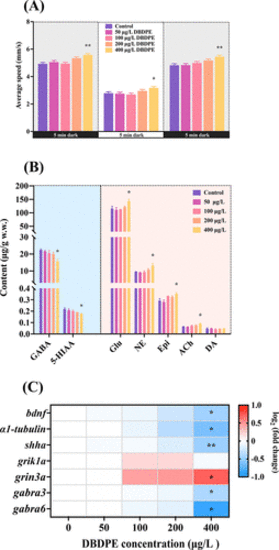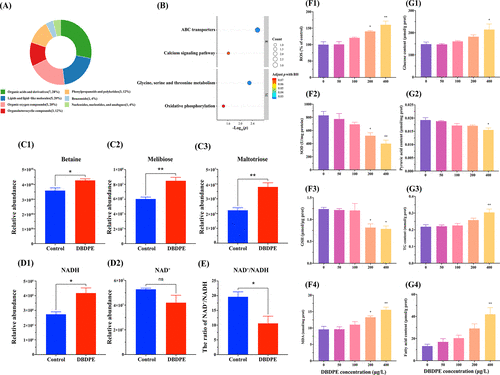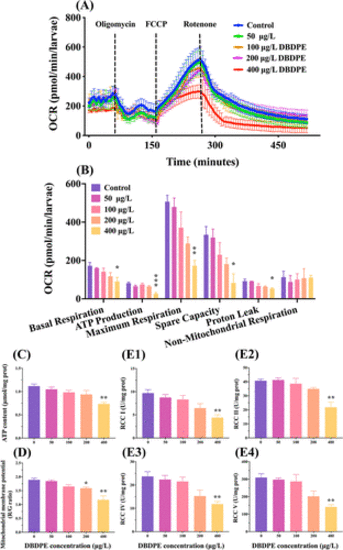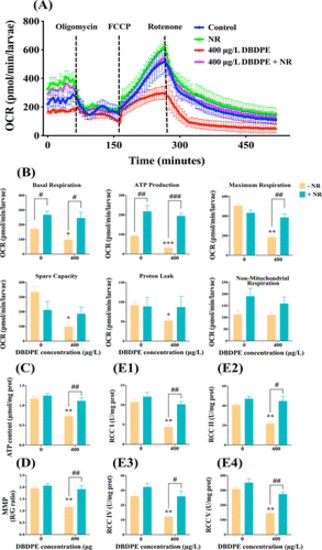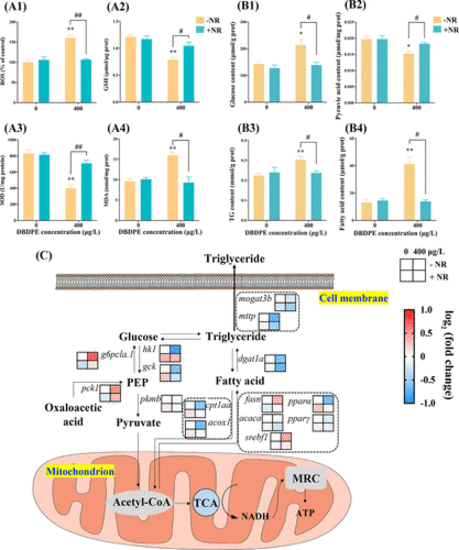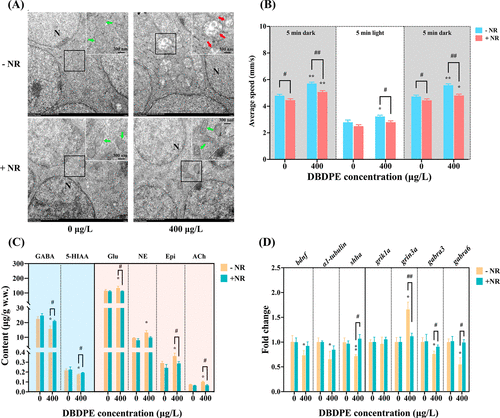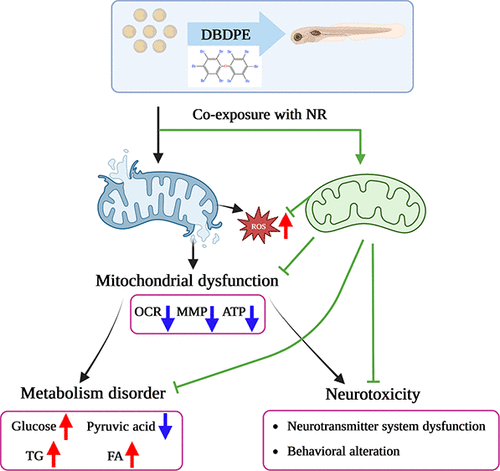- Title
-
Mitochondrial Dysfunction Was Involved in Decabromodiphenyl Ethane-Induced Glucolipid Metabolism Disorders and Neurotoxicity in Zebrafish Larvae
- Authors
- Yang, L., Zhu, B., Zhou, S., Zhao, M., Li, R., Zhou, Y., Shi, X., Han, J., Zhang, W., Zhou, B.
- Source
- Full text @ Env. Sci. Tech.
|
Effects of DBDPE on neurodevelopment of zebrafish embryos/larvae. (A) Average swimming speeds of the larvae in response to dark–light–dark photoperiod stimulation; (B) Neurotransmitters levels and (C) transcripts of genes related to the CNS and genes in neurotransmitter signaling pathways in zebrafish larvae upon DBDPE exposure. Values are shown as mean ± SEM. *P < 0.05 and **P < 0.01 indicates significant differences between the exposure and control groups. |
|
(A) Classification of DMs; (B) DMs for enrichment in KEGG pathways; the specific DMs for (C) ABC transporters and (D) oxidative phosphorylation signaling pathway, respectively; (E) ratio of NAD+/NADH; and (F) oxidative status (e.g., ROS, SOD, GSH, and MDA) and (G) glycolipid metabolism parameters (e.g., glucose, pyruvic acid, TG, and fatty acid contents) in zebrafish larvae after exposure to DBDPE. Data are presented as the mean ± SEM of four replicates. *P < 0.05 and **P < 0.01 indicate significant differences between the exposure and control groups. |
|
(A) Mitochondrial stress test (MST) was performed on Seahorse; (B) mitochondrial activity parameters were measured from MST; changes in (C) ATP content, (D) MMP, and (E) mitochondrial respiratory chain complex I, II, IV, and V activities in zebrafish larvae after exposure to DBDPE for 120 h. Values are presented as the mean ± SEM of four replicates. Values are shown as the mean ± SEM of four replicates. *P < 0.05, **P < 0.01, and ***P < 0.001 indicate significant differences between the exposure and control groups. |
|
(A) OCR results, (B) mitochondrial activity parameters, (C) ATP content, (D) MMP, and (E) mitochondrial respiratory chain complex (RCC I, II, IV, and V) activities from zebrafish larvae after exposure to DBDPE, with or without administration of NR. Values are shown as the mean ± SEM of four replicates. *P < 0.05, **P < 0.01, and ***P < 0.001 indicate significant differences between the exposure and control groups; #P < 0.05, ##P < 0.01, and ###P < 0.001 indicate significant difference between coexposure groups and the 400 μg/L DBDPE single group. |
|
Changes in (A) oxidative status (e.g., ROS, GSH, SOD, CAT, and MDA levels), (B) glycolipid metabolism parameters (e.g., glucose, pyruvic acid, TG, and fatty acid contents), and (C) locations of the glycolipid metabolism-relevant genes from zebrafish larvae after exposure to DBDPE, with or without administration of NR. Red and blue colors indicate up- and downregulation at the transcriptional levels. The values are expressed as the mean ± SEM of four replicates. *P < 0.05 and **P < 0.01 indicate significant differences between the exposure and control groups; #P < 0.05 and ##P < 0.01 indicate significant difference between coexposure groups and the 400 μg/L DBDPE single group. |
|
Changes in (A) mitochondrial ultrastructure in neurons, (B) average swimming speeds of the larvae in response to dark–light–dark photoperiod stimulation, (C) neurotransmitter levels, and (D) transcripts of genes related to the CNS and genes in neurotransmitter signaling pathways in zebrafish larvae after 400 μg/L DBDPE single exposure or coexposure with 160 μg/L NR. Values are presented as the mean ± SEM of four replicates. *P < 0.05 and **P < 0.01 indicate significant differences between the exposure and control groups; #P < 0.05 and ##P < 0.01 indicate significant difference between the coexposure group and the 400 μg/L DBDPE single group. |
|
|

